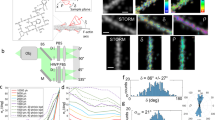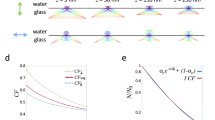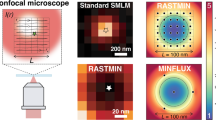Abstract
Knowledge of the orientation of molecules within biological structures is crucial to understanding the mechanisms of cell function. We present a method to image simultaneously the positions and fluorescence anisotropies of large numbers of single molecules with nanometer lateral resolution within a sample. Based on a simple modification of fluorescence photoactivation localization microscopy (FPALM), polarization (P)-FPALM does not compromise speed or sensitivity. We show results for mouse fibroblasts expressing Dendra2-actin or Dendra2-hemagglutinin.
This is a preview of subscription content, access via your institution
Access options
Subscribe to this journal
Receive 12 print issues and online access
$259.00 per year
only $21.58 per issue
Buy this article
- Purchase on Springer Link
- Instant access to full article PDF
Prices may be subject to local taxes which are calculated during checkout


Similar content being viewed by others
References
Hell, S.W. & Wichmann, J. Opt. Lett. 19, 780–782 (1994).
Hess, S.T., Girirajan, T.P. & Mason, M.D. Biophys. J. 91, 4258–4272 (2006).
Betzig, E. et al. Science 313, 1642–1645 (2006).
Rust, M.J., Bates, M. & Zhuang, X. Nat. Methods 3, 793–795 (2006).
Hess, S.T. et al. Proc. Natl. Acad. Sci. USA 104, 17370–17375 (2007).
Shroff, H., Galbraith, C.G., Galbraith, J.A. & Betzig, E. Nat. Methods 5, 417–423 (2008).
Huang, B., Wang, W., Bates, M. & Zhuang, X. Science 319, 810–813 (2008).
Juette, M.F. et al. Nat. Methods 5, 527–529 (2008).
Betzig, E. & Chichester, R.J. Science 262, 1422–1425 (1993).
Bartko, A.P. & Dickson, R.M. J. Phys. Chem. B 103, 11237–11241 (1999).
Bohmer, M. & Enderlein, J. J. Opt. Soc. Am. B 20, 554–559 (2003).
Harms, G.S., Cognet, L., Lommerse, P.H.M., Blab, G.A. & Schmidt, T. Biophys. J. 80, 2396–2408 (2001).
Patterson, G.H. & Lippincott-Schwartz, J. Science 297, 1873–1877 (2002).
Gurskaya, N.G. et al. Nat. Biotechnol. 24, 461–465 (2006).
Fourkas, J.T. Opt. Lett. 26, 211–213 (2001).
Lakowicz, J.R. Principles of Fluorescence Spectroscopy 3rd ed. (Springer Science, New York, 2006).
Weber, G. J. Opt. Soc. Am. 46, 962–970 (1956).
Hess, S.T., Sheets, E.D., Wagenknecht-Wiesner, A. & Heikal, A.A. Biophys. J. 85, 2566–2580 (2003).
Jacobson, K., Mouritsen, O.G. & Anderson, R.G. Nat. Cell Biol. 9, 7–14 (2007).
Acknowledgements
We thank C. Fang-Yen, P. Blank, J. Bewersdorf, J. Zimmerberg and M. Mason for useful discussions, G. Patterson (US National Institute of Child Health and Human Development) for providing the construct encoding the PA-GFP protein, J. Shim, J. Rochira and E. Allgeyer for laboratory assistance, A. McGinn, T. Tripp and P. Byard for professional services. This work was supported by grants K25-65459 from the US National Institute of Allergy and Infectious Diseases, CHE-0722759 from the National Science Foundation, start up funds from the University of Maine (S.T.H.), and by grants GM070358 and GM073913 from the National Institute of General Medical Sciences (V.V.V.).
Author information
Authors and Affiliations
Contributions
T.J.G. and M.S.G. conceived the method, performed and analyzed experiments, wrote and edited the manuscript. M.V.G. performed experiments and edited the manuscript. V.V.V. and S.-R.Y. created genetic constructs and edited the manuscript. J.A.G. assisted with experiments and analysis, and edited the manuscript. S.T.H. conceived the method, performed and analyzed experiments, wrote and edited the manuscript.
Corresponding author
Ethics declarations
Competing interests
T.J.G., M.S.G., and S.T.H. have applied for a provisional patent on the instrumentation described in this manuscript.
Supplementary information
Supplementary Text and Figures
Supplementary Figures 1–17, Supplementary Tables 1–2, Supplementary Methods (PDF 4109 kb)
Rights and permissions
About this article
Cite this article
Gould, T., Gunewardene, M., Gudheti, M. et al. Nanoscale imaging of molecular positions and anisotropies. Nat Methods 5, 1027–1030 (2008). https://doi.org/10.1038/nmeth.1271
Received:
Accepted:
Published:
Issue Date:
DOI: https://doi.org/10.1038/nmeth.1271
This article is cited by
-
4polar-STORM polarized super-resolution imaging of actin filament organization in cells
Nature Communications (2022)
-
Simultaneous orientation and 3D localization microscopy with a Vortex point spread function
Nature Communications (2021)
-
Super-resolution imaging of fluorescent dipoles via polarized structured illumination microscopy
Nature Communications (2019)
-
Super-resolution imaging of light–matter interactions near single semiconductor nanowires
Nature Communications (2016)
-
Fluorescent Photo-conversion: A Second Chance to Label Unique Cells
Cellular and Molecular Bioengineering (2015)



